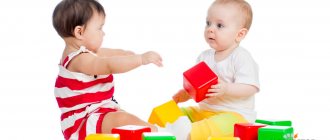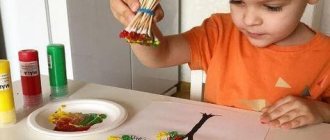Article “Cognitive and speech development of preschool children”
Author: Donchenko Irina Andreevna, teacher at MBDOU combined type kindergarten No. 48 (Apatity, Murmansk region).
It is known that preschool age is a favorable period for the development of all aspects of speech, expansion and enrichment of children's ideas about the diversity of the world around them. Therefore, the task of a kindergarten is not to quickly teach a child to write and count, but to enrich his speech and ideas about the world around him, to teach him to see patterns in it.
According to the Federal State Educational Standard for Preschool Education (FSES DO), educational areas represent the following areas of child development:
— social and communicative development;
— cognitive development;
- speech development;
- artistic - aesthetic;
- physical development.
Cognitive - speech development was divided into two independent areas.
Cognitive development involves the development of children's interests, curiosity and cognitive motivation; formation of cognitive actions, formation of consciousness; development of imagination and creative activity; the formation of primary ideas about oneself, other people, objects of the surrounding world, about the properties and relationships of objects of the surrounding world (shape, color, size, material, sound, rhythm, tempo, quantity, number, part and whole, space and time, movement and rest , causes and consequences, etc.), about the small homeland and Fatherland, ideas about the socio-cultural values of our people, about domestic traditions and holidays, about planet Earth as the common home of people, about the peculiarities of its nature, the diversity of countries and peoples of the world.
Speech development includes mastery of speech as a means of communication and culture; enrichment of the active vocabulary; development of coherent, grammatically correct dialogical and monologue speech; development of speech creativity; development of sound and intonation culture of speech, phonemic hearing; acquaintance with book culture, children's literature, listening comprehension of texts of various genres of children's literature; formation of sound analytical-synthetic activity as a prerequisite for learning to read and write.
Research by L.S. Vygotsky, L.A. Wenger, A.G. Zaporozhets show that cognitive interest is formed more successfully with active cognitive activity. It manifests itself in the desire to learn new things, to find out what is unclear about the qualities, properties of objects, phenomena of reality, in the desire to understand their essence, to find existing relationships and connections between them. Speech is inextricably linked with cognition.
During preschool childhood, thanks to the child’s cognitive activity, the emergence of a primary image of the world occurs. The image of the world is formed in the process of child development. However, it should be remembered that the process of cognition of a small person differs from the process of cognition of an adult. Adults understand the world with their minds, and small children with their emotions. For adults, information is primary, and attitude is secondary. But with children it’s the other way around: attitude is primary, information is secondary. It is important from the very first steps of a child to teach him a holistic view of the world, to give him an incomplete, but holistic picture of the world. A child learns about the world by comparing it with himself, as the object most known to him. In the process of becoming familiar with the environment, the preschooler develops in the cognitive sphere; the ability to see the world from the point of view of others develops, speech develops. Familiarization with the world around us enriches the child’s sensory experience and teaches him to be attentive to what surrounds him. Children learn to see, listen, feel and touch, thereby creating a sensory basis for the word.
Pedagogical problems are successfully solved with the right choice of methods and techniques. Considering that visual thinking predominates in preschoolers, I widely use visuals - exhibition material, toys, paintings, natural objects. We use specially organized situations and games that help increase attention, interest in the lesson and in speech activity. In the game, children learn to identify different and similar features, group objects according to individual characteristics, and recognize the qualities of an object.
To enrich and activate the vocabulary, speech games and exercises are carried out: “Say it in one word”, “Who needs these items”, “Learn the whole from the part”. Speech games are useful, during which the child must select as many attributes as possible for an object, for example, “What are they made of,” “Guess the taste.” Work on enriching vocabulary is carried out simultaneously with improving sound pronunciation and the formation of the grammatical structure of speech. Much attention is paid to logorhythmic exercises, finger games, exercises and games for the development of fine motor skills (various inserts, stringing objects on a cord), round dance games, games of low mobility, dramatization games, since the development of general and fine motor skills contributes to the development of speech.
An important role is played by listening to stories, fairy tales and poems, artistic creativity: drawing, modeling, appliqué, designing from building materials.
In the process of play activity, asking questions of the child and stimulating the imagination and creativity of children, we force him to independently discover the world around him and its patterns, children model real and fictional situations in the world they have created.
In the process of cognitive activity, thinking and speech develop. Thinking and speech are interconnected. Along with speech development, mental work skills are acquired, the ability to analyze, explain, prove, and reason is improved.
For the development of thinking and speech, a rich sensory experience is necessary, which is obtained from the perception of various objects of the world, nature, and social life.
From the earliest stages of a child’s development, it is necessary to introduce him to all the diversity of the world around him. Direct observation of the environment contributes to the development of logical speech and understanding of grammatical laws. To improve a child’s thoughts and words, it is necessary to enrich his soul with complete, true, vivid images of the world around him.
The ability to observe, developed in the process of cognition of the environment, gives rise to the habit of drawing conclusions, fosters the logic of thought, clarity and beauty of speech - the development of thinking and speech occurs as a single process.
The process of cognition of the environment in all its diversity contributes to the understanding and use in coherent speech of various grammatical categories that denote name, action, quality and help to analyze an object and phenomenon from all sides.
So, we can distinguish three tasks for the formation of speech through cognitive activity:
1. consistent formation of knowledge, taking into account the capabilities and characteristics of the surrounding world.
2. selection of methods and methods for developing speech through cognitive activity.
3. the use of various forms of organization for preschoolers when familiarizing themselves with the environment.
Thus, for preschool children, cognitive and speech development is a complex phenomenon that includes the formation of mental processes. But if the teacher approaches solving the problems of this section competently and creatively, then children will not have problems mastering the tasks, but on the contrary, there is a process of deepening and systematizing knowledge about the surrounding reality. The form of expression of thoughts is being improved: vocabulary is enriched, clarity and consistency of presentation, and emotional speech are achieved.
Norms of speech development in a preschooler from 3 to 7 years old
The results of studies of the speech of preschoolers make it possible to establish average indicators. Let's consider what levels of speech development are expected at each age stage - for younger, middle and older preschoolers. For convenience, we present the data in a table.
Table. Approximate norms for speech development of preschool children
| Age | Lexicon | Level of speech development |
| 3-4 years | up to 1900 words | Speech is situational, using indefinite forms there, like that. Makes simple sentences. Uses verbs, nouns and pronouns (often demonstrative this, that). Pronunciation: softens the sound, does not pronounce the sound R, less often – L, K, G. replaces hissing sounds with whistling ones. |
| 4-5.5 years | 2000-2500 words | Expands the use of adjectives. Literally understands the meaning of the word. He is interested in the sound of words, composes rhymes and new consonant words. Uses diminutive suffixes. Uses conjunctions a, and, but, as well as subordinates that, when, because... Expresses quantitative and qualitative relationships: many-few, high-low... Pronunciation: overcomes softening, masters almost all sounds, partially copes with the pronunciation of R. |
| 5.5-7 years | up to 4000 words | Speech is coherent and detailed. Composes messages from several sentences united by a common meaning. Builds sentences correctly from a grammatical point of view. Modifies words using suffixes. Masters the declension of nouns and the conjugation of verbs. Sound pronunciation must be correct. |
Development of children's speech in different types of activities
The relationship between speech and the content of activity intensifies with age. The need for verbal expression differs in different types of activities.
While playing with his toy, the preschooler conducts a dialogue with it. This one-sided conversation can be internal, not expressed in words. But more often the child says out loud all his calls to his toy friend.
Playing with peers offers other conditions. It is necessary to contact your partner, it is also important to hear him and exchange information. If at younger preschool age verbal communication in the game is simple and may be limited to role-playing participation, then older preschoolers often use explanatory speech.
The speech of a preschooler, which presents a holistic message and fully describes the situation, is called explanatory.
Explanatory speech develops well when preschoolers agree on the rules of the game or coordinated actions and explain the structure of the toy.
The creative activity of a preschooler is also permeated with speech. A child's drawing often needs explanation. And not only due to the fact that the adult asks what is shown on the sheet. More often than not, the author himself wants to tell what he drew. Speech description invariably enriches the content of the picture. Or dots the i's if something incomprehensible is depicted.
With the help of speech, children convey the character of their characters, thus overcoming the limitations of their own artistic abilities.
Parents' activity in the development of their child's speech
It is important for parents to consider that each child has his own individual pace of development. Noticing problems in the development of speech in their child in the preschool period and some discrepancy with the norms, they should not jealously compare with others and catch up with their peers, at all costs. However, this issue cannot be ignored.
Parental assistance is necessary for a preschooler in cognitive and speech development. Children, with the support of their parents, successfully progress in the following areas:
- vocabulary formation
- word creation
- development of verbal description skills.
In everyday communication with a child, parents have hundreds of opportunities to use new concepts and explain what they mean. Such simple participation of adults will significantly expand the active vocabulary of a preschooler.
Word creation allows the child to better understand the language and contributes to the development of a sense of rhythm. In addition to benefits in speech development, this activity brings incredible pleasure to children. Emotional speech, joint invention of new words with mom or dad is always accompanied by laughter and a joyful mood.
Parents can successfully teach verbal descriptions to their child. An adult can tell stories and describe what is happening to a preschooler, giving an example of a coherent statement, and then invite him to similarly describe what he sees around him. These activities are easy to do and can be done in any environment - at home or on a walk.





